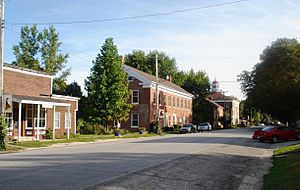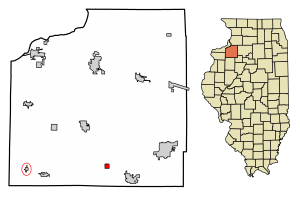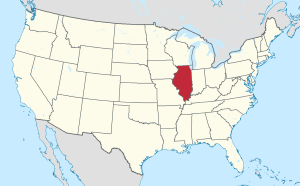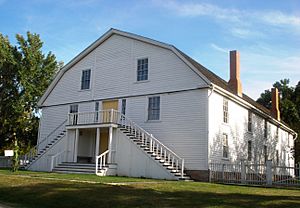Bishop Hill, Illinois facts for kids
Quick facts for kids
Bishop Hill
|
|
|---|---|

Bishop Hill Street
|
|

Location of Bishop Hill in Henry County, Illinois.
|
|

Location of Illinois in the United States
|
|
| Country | United States |
| State | Illinois |
| County | Henry |
| Area | |
| • Total | 0.53 sq mi (1.38 km2) |
| • Land | 0.53 sq mi (1.38 km2) |
| • Water | 0.00 sq mi (0.00 km2) |
| Population
(2020)
|
|
| • Total | 113 |
| • Density | 212.41/sq mi (82.03/km2) |
| Time zone | UTC-6 (CST) |
| • Summer (DST) | UTC-5 (CDT) |
| Area code(s) | 309 |
| FIPS code | 17-06171 |
| Wikimedia Commons | Bishop Hill, Illinois |
Bishop Hill is a small village in Henry County, Illinois, United States. It is located along the South Edwards River. In 2020, about 113 people lived there.
Bishop Hill is famous for being home to the Bishop Hill State Historic Site. This site is a park managed by the Illinois Historic Preservation Agency. It helps preserve the history of a unique community that once lived here.
Contents
Where is Bishop Hill?
Bishop Hill is located in Illinois. Its exact coordinates are 41°12′3″N 90°7′6″W / 41.20083°N 90.11833°W. The village covers a total area of about 0.53 square miles (1.38 square kilometers). All of this area is land.
A Unique History: The Bishop Hill Colony
The Vision of Eric Jansson
Bishop Hill was founded in 1846 by Swedish immigrants. These immigrants were part of a religious group called Pietists. Their leader was a man named Eric Jansson.
Before coming to America, Jansson taught his followers in Sweden. He believed the traditional Lutheran Church had problems. He also taught that truly faithful people could live without sin. As his ideas became more extreme, he faced difficulties in Sweden. He eventually had to leave his home country.
Jansson had sent a trusted friend, Olof Olsson, to the United States. Olsson's job was to find a good place for Jansson's followers to build a special community. Jansson believed this community would be a "New Jerusalem." He thought their beliefs would spread worldwide from there. About 1400 colonists traveled from Sweden to their new home in western Illinois.
Early Challenges and Growth
The new colony faced many challenges at first. Many of the first 1000 colonists died from sickness on their journey. Others became discouraged and stayed in New York. When they arrived in Bishop Hill, conditions were tough. The living spaces were cold and crowded, and food was hard to find. The village was named after Eric Jansson's birthplace, Biskopskulla.
After the first winter, life slowly got better. Over the next few years, their homes improved. They built brick buildings instead of simple dugouts. They also planted crops on about 700 acres (2.8 square kilometers) of land.
By 1849, Bishop Hill had grown a lot. They built a flour mill and two sawmills. They also constructed a large, three-story church made of wood. Many other buildings were added too. The Bishop Hill colony was a communistic community. This meant that everyone shared everything. No one owned more than anyone else. Work in the colony was very strict and organized. It was common to see hundreds of people working together in the fields. Large groups of workers also did other tasks.
Life After Jansson and Today
A big change happened in Bishop Hill in 1850. Eric Jansson, the leader, was killed by a former colony member. After Jansson's death, the people of Bishop Hill chose seven trustees to manage the colony. Jonas Olsson and Olof Johnson became the main leaders. They had been close helpers to Jansson.
Under these new leaders, the colony continued to grow and do well. They organized the work to be more efficient. More buildings were built. However, by 1857, the colony started having money problems. There were accusations that Olof Johnson had managed money poorly. He had made some very large investments without the colony's approval. These investments turned out to be bad.
As Bishop Hill faced financial ruin, the colonists decided to end their shared way of life. In 1861, the colony officially broke up. Many of its people soon had to move away.
The Janssonist emigrants were an important group of people who moved from Sweden to the United States. They wrote letters home to their friends and family. These letters described the rich farmland in North America. Their stories encouraged many more Swedes to move to the U.S. for several decades. This helped create the Swedish-American community in the American Midwest.
Some of the buildings built by the Janssonists are still standing today. They are listed on the National Register of Historic Places. Bishop Hill is now seen as a living example of Swedish-American heritage. It shows how these early settlers lived.
Who Lives in Bishop Hill?
| Historical population | |||
|---|---|---|---|
| Census | Pop. | %± | |
| 1880 | 350 | — | |
| 1890 | 330 | −5.7% | |
| 1900 | 345 | 4.5% | |
| 1910 | 289 | −16.2% | |
| 1920 | 274 | −5.2% | |
| 1930 | 208 | −24.1% | |
| 1940 | 199 | −4.3% | |
| 1950 | 202 | 1.5% | |
| 1960 | 164 | −18.8% | |
| 1970 | 191 | 16.5% | |
| 1980 | 166 | −13.1% | |
| 1990 | 131 | −21.1% | |
| 2000 | 125 | −4.6% | |
| 2010 | 128 | 2.4% | |
| 2020 | 113 | −11.7% | |
| U.S. Decennial Census | |||
According to the 2020 census, 113 people lived in Bishop Hill. There were 53 households, and 29 of them were families. Most people living in the village were White.
- About 7.5% of households had children under 18.
- About 43.4% were married couples living together.
- About 41.5% of all households were single individuals.
- About 24.5% of people lived alone and were 65 years or older.
The average age of people in the village was 62.4 years.
Famous People from Bishop Hill
- Hick Cady: A baseball catcher who played for the Boston Red Sox and Philadelphia Phillies.
- Roy Magnuson: A composer and music professor at Illinois State University.
See also
 In Spanish: Bishop Hill para niños
In Spanish: Bishop Hill para niños


